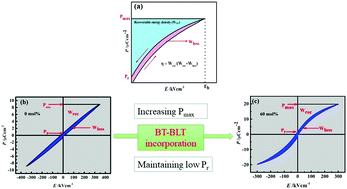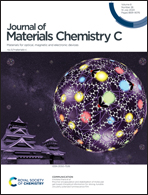Lead-free relaxor-ferroelectric ceramics for high-energy-storage applications
Abstract
Relaxor-ferroelectric ceramics capacitors have been in the front lines of investigations aimed at optimizing energy density due to their high Pmax, suppressed Pr, and high BDS levels, attributed to their highly dynamic polar nano-regions. A set of (1 − x)SrTiO3–x[0.88BaTiO3–0.12Bi(Li0.5Ta0.5)O3] ceramics (x = 0, 20, 40, 60 and 80 mol%), abbreviated as (1 − x)ST–x(BT–BLT), was designed and fabricated via a solid-state reaction route. A striking energy-storage density of 2.24 J cm−3, coupled with a high efficiency of η = 81% at 300 kV cm−1, was measured for these (1 − x)ST–x(BT–BLT) ceramics. The incorporation of BT–BLT ceramics was found to dramatically transform the paraelectric state of strontium titanate into the relaxor-ferroelectric state, by introducing broad relaxor behavior. The energy storage properties of the ceramic with x = 60 mol% showed outstanding stability in frequency (10–100 Hz) and temperature (20–120 °C), with minimal variation of (±≤0.5%), over the course of 105 cycles. Moreover, under various electric fields, rapid charge and discharge (≤1.5 μs) was also observed for this x = 60 mol% ceramic. Most significantly, the outcomes of this study are expected to provide a standard for other emerging lead-free dielectric ceramics displaying very good energy-storage properties and excellent electric field endurance, which are of pragmatic importance for cutting-edge pulsed power technology.



 Please wait while we load your content...
Please wait while we load your content...